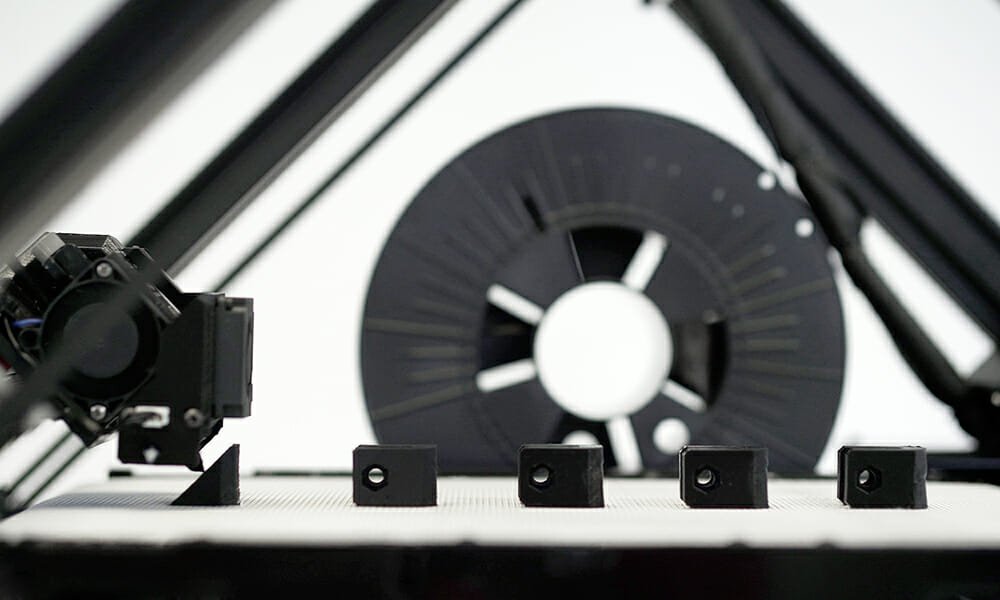In recent years, additive manufacturing, commonly known as 3D printing, has revolutionized the manufacturing industry by enabling the production of complex objects with unmatched precision at sufficient speed. The constant advances in this field have paved the way for a new era of manufacturing, where customization and flexibility are the most important factors. Here, another breakthrough is the combination of 3D printer and conveyor belt, which offers unprecedented opportunities for mass customization and cost savings. In this post, we explore how this innovative technology enables companies, particularly in the automotive industry, to achieve high levels of customization and significant economic benefits.
Unleashing the potential of mass customization
Mass customization has long been a desirable goal in the manufacturing industry, as it allows companies to meet the individual preferences and requirements of each customer while maintaining economies of scale. Traditional mass customization processes rely on a combination of manual labor and complex tooling. Customization is performed on selected details, such as design features or fit. For the manufacturer, these are minor changes, but they suggest to the customer a high degree of individuality and influence on the final product. The concept of modularization is often used, where a product is individually assembled from various individual parts. With this method, the additional costs are reduced to a minimum, and which the customer is usually willing to accept. Automated additive manufacturing processes serve the trend toward mass costumization even more precisely than is the case today.
By integrating a conveyor belt system with the 3D printer, companies are able to produce customized products on a large scale without the need for extensive retooling or manual intervention. Each product can be tailored to the customer’s exact specifications, while the automated process ensures efficient production. This level of flexibility was previously unattainable even with the most advanced mass customization techniques.
Individuality beyond conventional limits
With 3D conveyor belt printers, a higher level of customization can be achieved than with conventional mass customization techniques. While conventional manufacturing techniques often limit customization to specific parameters or predefined options, the integration of 3D printing offers limitless possibilities. Customers can now obtain products tailored precisely to their wishes, especially in terms of design, size and texture, but material and color can also be influenced without any major action. This high degree of customizability can both favor a positioning as an innovation leader of the manufacturer in the respective field, as well as accommodate the trend of the open innovation concept. In this case, input from different customers creates new product variants, which in turn can be targeted at the mass market.
This unprecedented degree of individuality is also of great importance in the automotive industry. Here, the small iterations, which tend to be aimed at slightly different target groups, are characterized by model variants such as Sport, Luxury, Urban Edition, and so on. However, it is also possible to cater to different wishes of demanding customers by individualizing aspects of a vehicle such as the interior, exterior design and even functional components. The implementation of these variations ranges from simple mass customization measures to very specific ones that can actually only be realized through craftsmanship or more cost-effectively through AM technology. Integrating 3D printing with belt technology allows for streamlined and cost-effective production of these custom parts.
Achieve cost savings and efficiency
3D conveyor belt printers not only enable the production of customized mass-produced parts, but also offer significant cost savings for companies. A German plant of an internationally successful automotive manufacturer plans to introduce this technology in the form of iFactory3D‘s One Pro 3D conveyor belt printer in the near future. By integrating a versatile 3D conveyor belt printer, the company expects to save a total of around 50,000 euros per year in labor and material costs. In this case, the device is to be used especially for the local production of important, specific tools that were previously procured externally and only created universally. This means that rework has to be done manually in the factory to adapt them to individual product requirements. With the 3D belt printer, an automated process takes its place where minimal adjustments can be made digitally and implemented directly. The need for manual intervention is thus minimized, as are logistics costs. In addition, staff operation is exceptionally low, as the AM machine can run around the clock with remote monitoring. This results in an overall reduction in costs, with a large portion of the costs being attributable to personnel. However, as costs fall, operational efficiency increases.
Direct access to tool production, without long communication and delivery lines, allows optimal solutions for any operation. Modular tool/mold designs or the adaptation of only very small components cover a wide range of applications. And for highly complex applications, an individual tool model can be created promptly at any time. In-house production with multifunctional AM technology means that high initial investments, regular maintenance by external parties and time-consuming set-up processes can be partially avoided. By using 3D belt printers, the automotive company can minimize tooling costs and quickly adapt to design changes, increasing productivity and overall profitability.
Shaping the path into a new manufacturing era
The incorporation of 3D printers with an integrated conveyor belt as a print surface, creating automation, represents an important milestone in additive manufacturing. With this technology, companies, particularly in the automotive industry, can achieve unprecedented levels of customization and personalization while achieving significant cost savings. The ability to manufacture customized products on a large scale without extensive retooling or manual labor is revolutionizing mass manufacturing and enabling companies to easily meet the unique needs of their customers.
The future of manufacturing clearly lies in the use and addition of flexible and efficient technologies such as 3D conveyor belt printers. By harnessing the power of automation and additive manufacturing, companies can stay ahead of the curve, adapt to changing customer needs, and help shape the path for a new era of manufacturing.
 Serial production
Serial production
